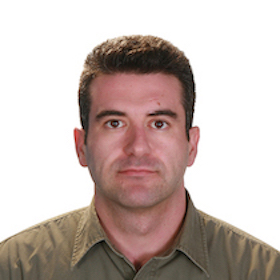Staff Spotlight: Christos Malliakas

By Irena Garic
About Dr. Christos Malliakas
Dr. Christos Malliakas joined the Integrated Molecular Structure Education and Research Center (IMSERC) facility in January 2016 as an X-Ray Crystallography specialists, and just few months ago was promoted to Research Associate Professor. Christos has extensive experience in non-classical crystallographic techniques such as incommensurate modulated structure and total scattering diffraction methods.
Christos received his B.S. in Chemistry and M.S. in Solid State Physics from Aristotle University of Thessaloniki, Greece. Christos received his Ph.D. at Michigan State University under the direction of Professor Mercouri Kanatzidis. He completed his post-doctoral work in the Emerging Materials group at the Materials Science Division at Argonne National Laboratory under John Mitchell’s leadership.
Highlights from Dr. Malliakas’ Research at IMSERC
Crystallography is the study of the atomic structures of crystals, where the diffraction or reflection of x-rays through the crystal is used to determine the crystal's internal structure. Crystal structure has influence on a wide range of useful physical properties from magnetism and conductivity to catalytic activity and chemical reactivity.
What part of your research do you find most interesting?
Metal-Organic Frameworks (MOFs) are a fascinating class of compounds where basic molecular building blocks and simple precursors can be combined to create complex materials with repeating, extended structures. MOFs are built from metal ions and organic struts. There is a huge library of combinations of different organic bridges and metals that give rise to a large number of MOFs exhibiting exciting structural topologies and physico-chemical properties. Because of the rational design of MOFs, theoretical predictions of new members and their properties is possible even before synthesizing the actual materials. As MOFs have an incredibly high surface area which can be activated, or tailored to have a specific chemistry, they can be used for tailored catalysis, gas storage and purifications.
How does crystallography help in the synthesis of MOFs?
Precise atomic models obtained using crystallographic techniques are crucial for the investigation of the different topologies and structures of MOFs. Through structural analyses, a correlation between the size, shape, and chemistry of the organic building blocks with various metals can be made. Once these chemical and physical interactions are fully understood, strategic modification to any of the structural components can be used to synthesise specific topologies and tailor the MOF properties. For example, a simple substitution on an organic ligand can change the degree of catenation between frameworks. Subtle changes in MOF structure can be used to fine-tune catalysis so a comprehensive understanding of MOF design is a holy grail for modern chemists and solid-state physicists.
What additional information does crystallography provide for the analysis of MOFs?
Chemists can be very creative and synthesize many different organic building blocks with different functional groups and properties. When these organic molecules are used in the synthesis of MOFs, new and exciting properties may rise, such as specific sites for catalysis, separation of gas molecules, gas storage, etc. Crystallography for example can be used to identify catalytic sites or even predict from the structure (through theoretical calculation) if pore size and internal surface are suitable for gas separation/storage applications. Additionally, in-situ crystallographic techniques can now probe the structural changes that may be responsible for key applications, such as the expansion/contraction (breathing effect) of the framework as a function of gas pressure.
American Crystallography Association (ACA) Summer Course
Christos is one of the organizers for the ACA Summer Course in Chemical Crystallography. This course was designed to instruct attendees in the theory and practice of these two aspects of crystallography. It is held every summer, in even years at the University of Norte Dame, and in odd years at Northwestern University.
